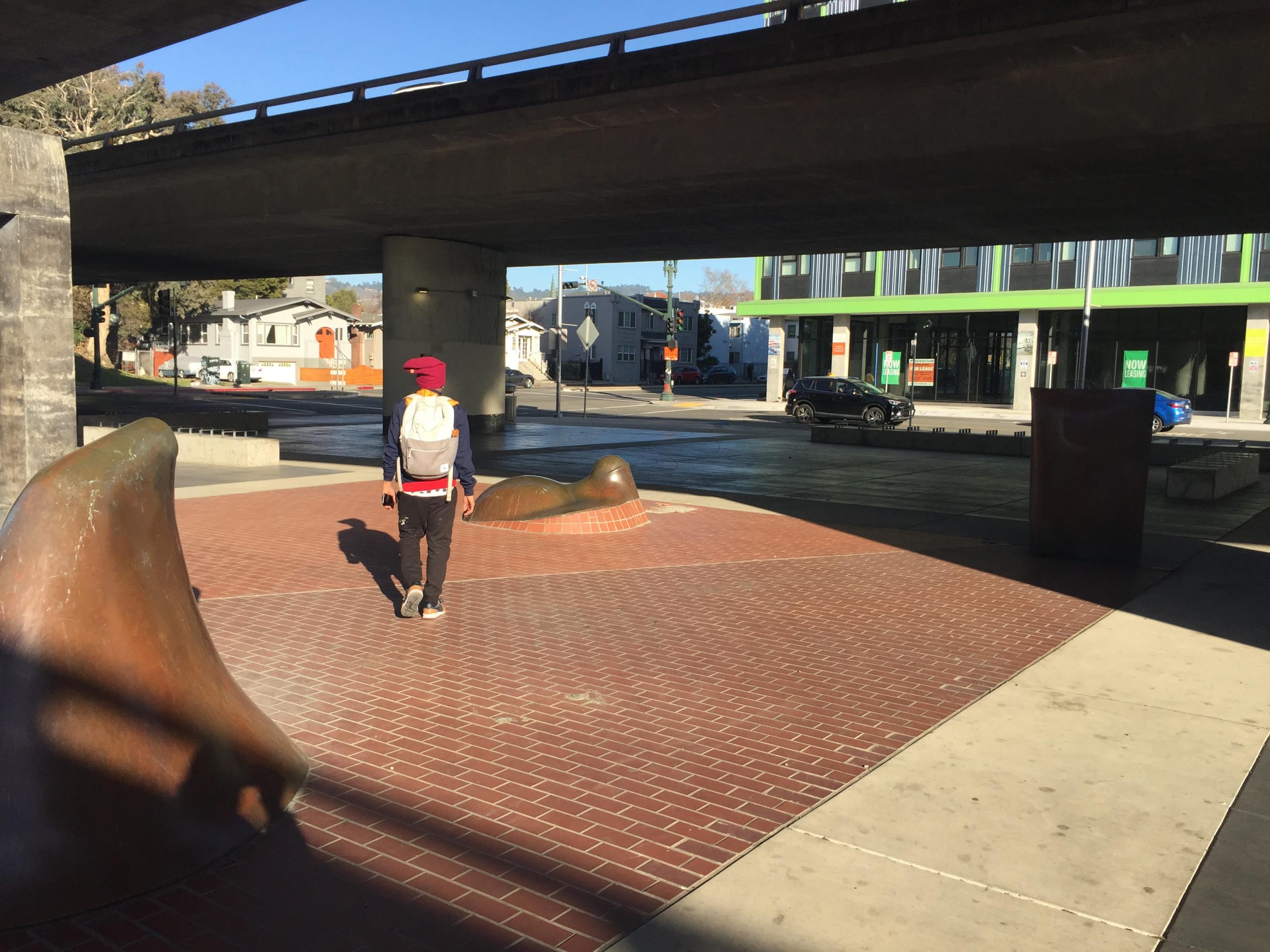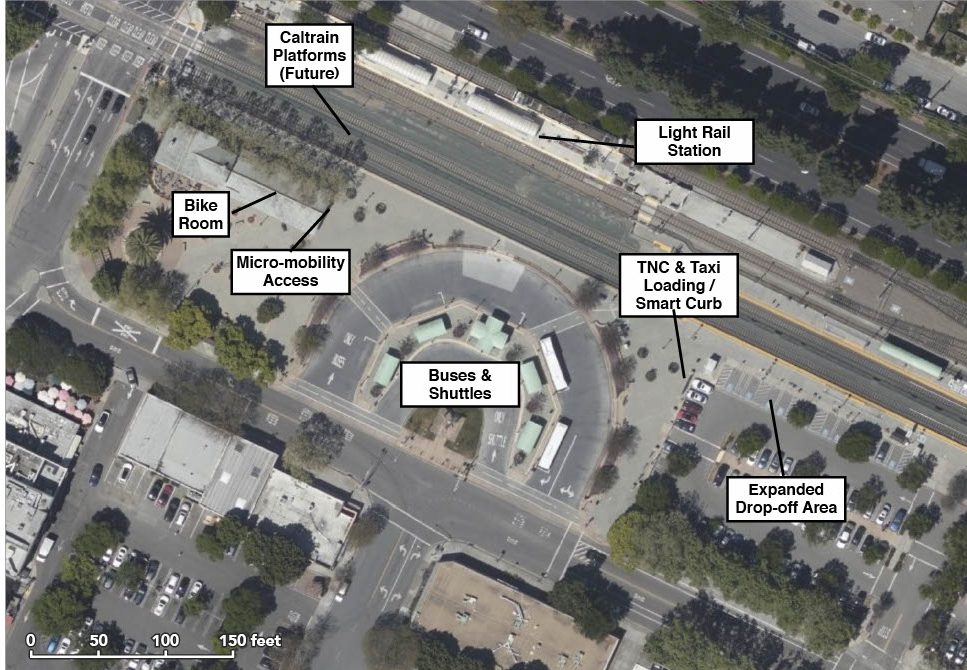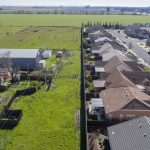
A traveler departs MacArthur Station. Credit: Office of BART District Architect
Commuters going in and out of the MacArthur BART Station in Oakland’s Temescal District consider the hub convenient because it runs multiple lines and frequent service. But the station isn’t necessarily known as a comfortable or convenient place where people stick around too long.
Transportation planners are looking to change that.
Seven sites across the Bay Area, including the MacArthur BART Station, will morph into mobility hubs in the next few years, clustering various transportation options and services into a safe, welcoming, and inclusive space to reduce the number of cars on roads.
A mobility hubs pilot program approved by the Metropolitan Transportation Commission (MTC) on September 22 drives the transformation. It defines mobility hubs as “community anchors that enable travelers of all backgrounds and abilities to access multiple transportation options — including shared scooters, bicycles and cars, and transit — as well as supportive amenities in a cohesive space,” according to meeting materials.
MTC officials believe the pilot will help lower greenhouse gas emissions by reducing vehicle-miles traveled (VMT) and contributing to daily commute habit changes in the future.
The goal is that the regional program would make it easier for people to hop between transportation modes, whether rail to an electric scooter or bus to car-share and bridge first-and-last-mile connection gaps. Hubs also can be conceived as a place to go. They can provide seating, bike charging, bike-fix stations, wayfinding signs, and other types of “place-making” design features to integrate transit areas into the community.
Cities such as “Oakland and San Francisco have bike-share stations next to bus stops, so these multi-modal hubs already exist,” said Krute Singa, principal regional planner at MTC. “What is missing from all these locations is place-making elements.”
Pilot sites chosen for mobility makeovers include the MacArthur BART Station, Bishop Ranch Business Park, the Temporary Transbay Terminal, Caltrain Burlingame Station/Burlingame Square Transit Hub, Millbrae BART and Caltrain Station/Millbrae Transit Center, Mountain View Caltrain Station/Transit Center, and the Vallejo Ferry Terminal.
Each has an existing bus, rail, ferry, bike-share, or car-share anchor service and resides in a priority development area, equity priority community, or other high-resource areas.
Mobility hubs live in MTC’s climate initiative strategy in Plan Bay Area (PBA) 2050 and PBA 2040. The transportation planning agency granted $2.7 million in funding to launch the regional pilot program across the sites.
It also earmarked an additional $150,000 for place-making assistance to help BART and cities involved in the pilot create well-functioning hubs. One potential challenge for pilot participants could be attracting private mobility vendors to areas that are outside their business model, Singa said.
Mobility hubs aren’t necessarily a fresh concept, Singa added, but growth in transportation options, coupled with hubs’ community emphasis, underscores the opportunity.
Public feedback from a 2019, three-month mobility hub pilot in Minneapolis also reflects the potential. About 64 percent of Minneapolis users said improved place-making and wayfinding “make them more likely” to use the mobility hub’s transportation options.
Meanwhile, similar interest in tackling carbon reduction goals is driving mobility hub planning efforts in other parts of California like San Diego and Orange County.

Planned layout for Mountain View Mobility Hub. Credit: City of Mountain View
‘Sense of Cohesiveness’
As the region continues to recover from the COVID-19 pandemic, the Bay Area Monitor talked to officials representing MacArthur BART and the City of Mountain View to hear what’s in store. Cities and transit agencies may follow a mobility hub definition that’s similar to MTC’s, or come up with their own.
BART staff creating the mobility hub at MacArthur Station plan a range of wayfinding improvements at this central transfer point. Wayfinding signs identifying the hub and transit connections, real-time departures, maps, an information kiosk, and micro-mobility solar charging for e-bikes and scooters are in the works. So, too, is a smartphone app that helps people with visual impairments map out the station area.
The MacArthur Station mobility hub will create a “sense of cohesiveness at this important North Oakland location” to connect travelers to various active transit options, said Tian Feng, BART District architect. He added that new features might attract street vendors and food trucks to the plaza in front of the station in the future.
Construction on MacArthur BART Station will begin in late 2022 and wrap up by early 2024. BART received $750,000 as part of the pilot program and is seeking additional funding.
Further south in Mountain View, a new bike storage room in the Transit Center Station, a gateway to the downtown area and a key transfer point for Silicon Valley employees, is considered the most “significant element of the pilot,” said Dawn Cameron, public works director. Bike room upgrades, including added capacity, will be completed as early as possible in 2022 and will appeal to daily transit and other users.
Cameron said other planned improvements include charging facilities for e-bikes and scooters and new potential car-sharing and on-demand transit services. Participation in the mobility hubs pilot would also help the city implement its Mountain View Master Transit Plan (2018) and support other projects, including the expansion of Caltrain service, she added. The city received $200,000 from MTC to start the hub.
MTC will provide a pilot project update in the summer of 2022 and consider the next steps for a subsequent round of funding. The outcome of the first seven projects could inform MTC about the potential for a regional mobility hubs program in the future, Singa said.

